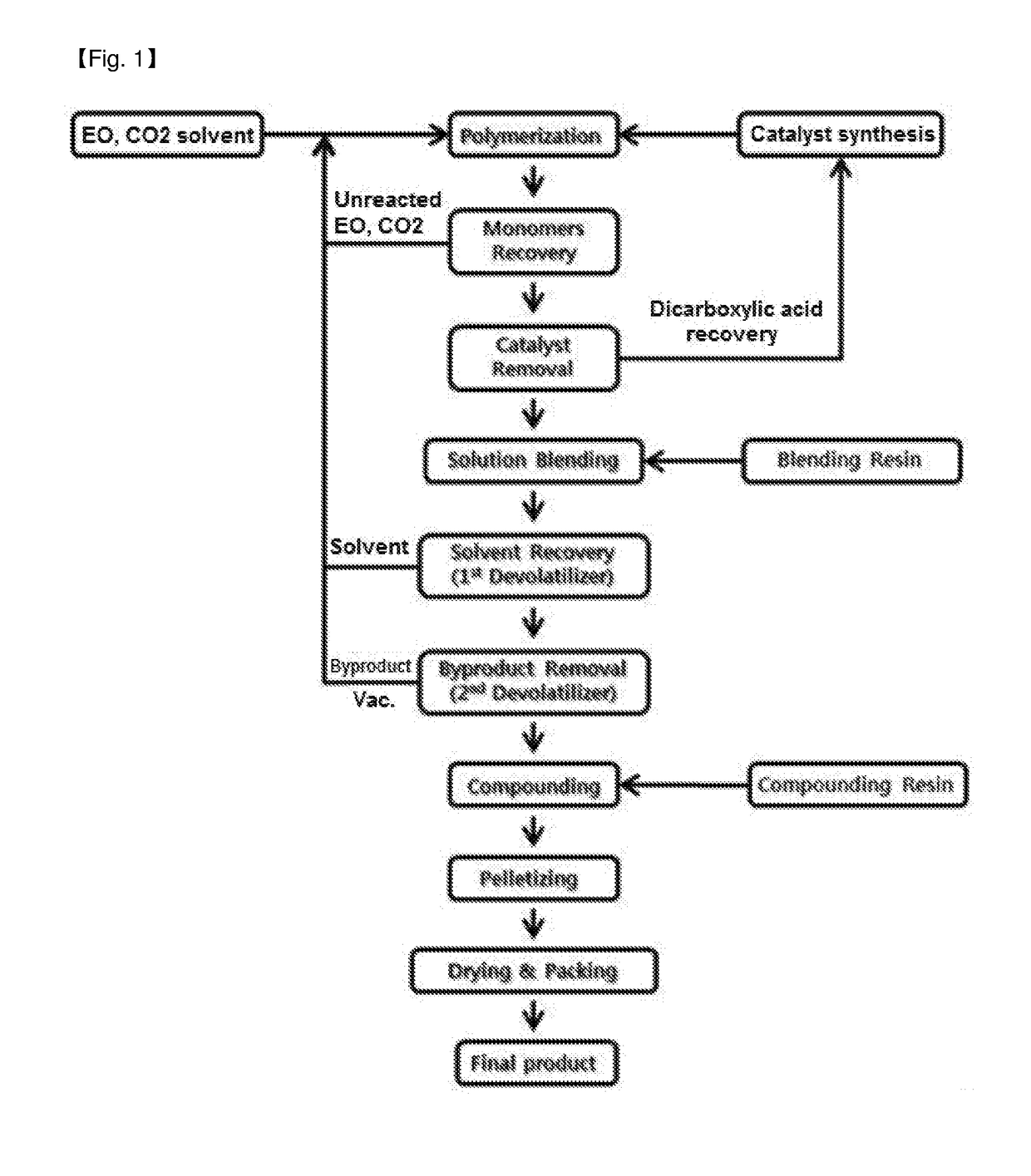An economical method of preparing a resin composition including polyalkylene carbonate with improved thermal stability and processability
a technology applied in the economic field of preparing a resin composition including a polyalkylene carbonate with improved can solve the problems of poor thermal stability and poor processability of polyalkylene carbonate, narrow processing temperature range, easy decomposition of resin, etc., to improve the low improve the effect of thermal stability and processability
- Summary
- Abstract
- Description
- Claims
- Application Information
AI Technical Summary
Benefits of technology
Problems solved by technology
Method used
Image
Examples
preparation example
nic Zinc Catalyst (Molar Ratio of Glutaric Acid:ZnO=1:1)
[0167]In a 160 L reactor, 11.9 kg (189.3 mol) of glutaric acid was dispersed in 100 L of toluene under reflux and heated at 55° C. for 30 minutes.
[0168]Separately, 7.3 kg (190 mol) of ZnO was added to 30 L of toluene and stirred to prepare a ZnO dispersion.
[0169]The ZnO dispersion was divided into quarters based on the volume, and one quarter of the dispersion was added to the glutaric acid solution to carry out the reaction. After one hour, another quarter of the ZnO dispersion was added to carry out the reaction, and one hour later, another quarter of the ZnO dispersion was added to carry out the reaction. After one hour, the last quarter of the ZnO dispersion was added to carry out the reaction. The reaction mixture was reacted at 55° C., raised to 110° C., and heated for 3 hours to remove water generated during the synthesis by using a Dean-Stark apparatus. After a white solid was formed, it was filtered, washed with aceton...
example 1
Molecular Weight and Selectivity of Polyalkylene Carbonate According to Moisture Content
[0174]Before the polymerization, carbon dioxide, ethylene oxide, and methylene chloride (hereinafter, CO2, EO, and MC) were sufficiently purified using a molecular sieve. After that, in order to control the molecular weight, distilled water was artificially introduced into MC to adjust the moisture content thereof to 21 ppm, and it was used for polymerization.
[0175]Then, a raw material feed tank, a polymerization reactor, an agitated flash drum and a twin-screw extruder for recovering the solvent, a twin-screw extruder for removing byproducts, an extruder for pelletizing, a centrifugal dryer, and a pellet recovery device were connected to each other and used in the method of preparing a resin composition containing a polyethylene carbonate.
[0176]First, a 1 m3 autoclave reactor equipped with a stirrer was used as the polymerization reactor. Then, the zinc-based catalyst obtained in the preparation...
example 2
Molecular Weight and Selectivity of Polyalkylene Carbonate According to Moisture Content
[0179]Before the polymerization, CO2, EO, and MC were sufficiently purified. After that, distilled water was artificially added so that the moisture content of MC was 68 ppm, and the polymerization proceeded. The same method as in Example 1 was used, and the amounts of the catalyst, CO2, EO, and MC were as shown in Table 1. Herein, a change in the ratio of the catalyst, the monomer, and MC was ignored since it does not affect the molecular weight and selectivity of the polyalkylene carbonate. (Comparative Example 2)
[0180]At this time, the obtained polyalkylene carbonate resin (i.e., PEC) had a weight average molecular weight of 240 kg / mol and showed selectivity of 93%.
PUM
| Property | Measurement | Unit |
|---|---|---|
| temperature | aaaaa | aaaaa |
| temperature | aaaaa | aaaaa |
| pressure | aaaaa | aaaaa |
Abstract
Description
Claims
Application Information
 Login to View More
Login to View More - R&D
- Intellectual Property
- Life Sciences
- Materials
- Tech Scout
- Unparalleled Data Quality
- Higher Quality Content
- 60% Fewer Hallucinations
Browse by: Latest US Patents, China's latest patents, Technical Efficacy Thesaurus, Application Domain, Technology Topic, Popular Technical Reports.
© 2025 PatSnap. All rights reserved.Legal|Privacy policy|Modern Slavery Act Transparency Statement|Sitemap|About US| Contact US: help@patsnap.com

